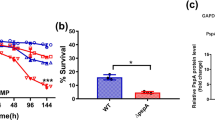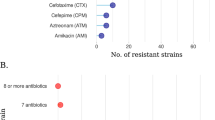Abstract
Escherichia coli, Pseudomonas fluorescens, and aPseudomonas sp. strain 133B containing the pSa plasmid were starved in well water for up to 523 days. There were two patterns of apparent antibiotic resistance loss observed. InPseudomonas sp. strain 133B, there was no apparent loss of antibiotic resistance even after starvation for 340 days. InE. coli, by day 49 there was a ten-fold difference between the number of cells that would grow on antibiotic- and nonantibiotic-containing plates. However, over 76% of the cells that apparently lost their antibiotic resistance were able to express antibiotic resistance after first being resuscitated on non-selective media. By day 523, only 12% of these cells were able to express their antibiotic resistance after being resuscitated. After starvation for 49 days, cells that could not grow on antibiotic medium even after resuscitation, showed a permanent loss of chloramphenicol (Cm) resistance but retained resistance to kanamycin (Km) and streptomycin (Sm). Restriction enzyme digests show that a 2.5 to 3.0 Kb region from map location 12.5 to 15.5 Kb was deleted. This coincides with the 2.5 Kb reduction in plasmid size observed in 3 isolates that had lost antibiotic resistance after starvation for 49 days.
Similar content being viewed by others
References
Ausubel FM, Brent R, Kingston RE, Moore DP, Smith JA, Seidman JG, Struhl K (1987) Current protocols in molecular biology. Greene Publishing Assoc. Wiley-Interscience, New York
Caldwell BA, Ye C, Griffiths RP, Moyer CL, Morita RY (1989) Plasmid expression and maintenance during long-term starvation-survival of bacteria in well water. Appl Environ Microbiol 55:1860–1864
Cruz-Cruz NE, Toranzos GA, Ahearn DG, Hazen TC (1988) In situ survival of plasmid-bearing and plasmidlessPseudomonas aeruginosa in pristine tropical waters. Appl Environ Microbiol 54:2574–2577
Devanas MA, Rafaeli-Eshkol D, Stotzky G (1986) Survival of plasmid-containing strains ofEscherichia coli in soil: Effect of plasmid size and nutrients on survival of hosts and maintenance of plasmids. Curr Microbiol 13:269–277
Ford S, Olson BH (1988) Methods for detecting genetically engineered microorganisms in the environment. Adv Microbiol Ecol 10:45–79
Ireland Valentine CR (1985) One-kilobase direct repeats of plasmid pSa. Plasmid 14:167–170
Jain RK, Sayler GS, Wilson JY, Houston L, Pacia D (1987) Maintenance and stability of introduced genotypes in groundwater aquifer material. Appl Environ Microbiol 53:996–1002
Maniatis T, Fritsch TE, Sambrook J (1982) Molecular cloning, a laboratory manual. Cold Spring Harbor Lab, New York
Strzelecki A, Goodman AE, Rogers PL (1987) Behavior in the IncW plasmid Sa inZymononas mobilis. Plasmid 18:46–53
Tait RC, Lundquest RC, Kado CI (1982) Genetic map of the crown gall suppressive IncW plasmid pSa. Mol Gen Genet 186:101–115
Ward JM, Grinsted J (1982) Physical and genetic analysis of the Inc-W group plasmids R388, Sa, and R7K. Plasmid 7:239–250
Author information
Authors and Affiliations
Additional information
Published as Technical Paper #9224, Oregon Agricultural Experiment Station.
Rights and permissions
About this article
Cite this article
Griffiths, R.P., Moyer, C.L., Caldwell, B.A. et al. Long-term starvation-induced loss of antibiotic resistance in bacteria. Microb Ecol 19, 251–257 (1990). https://doi.org/10.1007/BF02017169
Issue Date:
DOI: https://doi.org/10.1007/BF02017169




